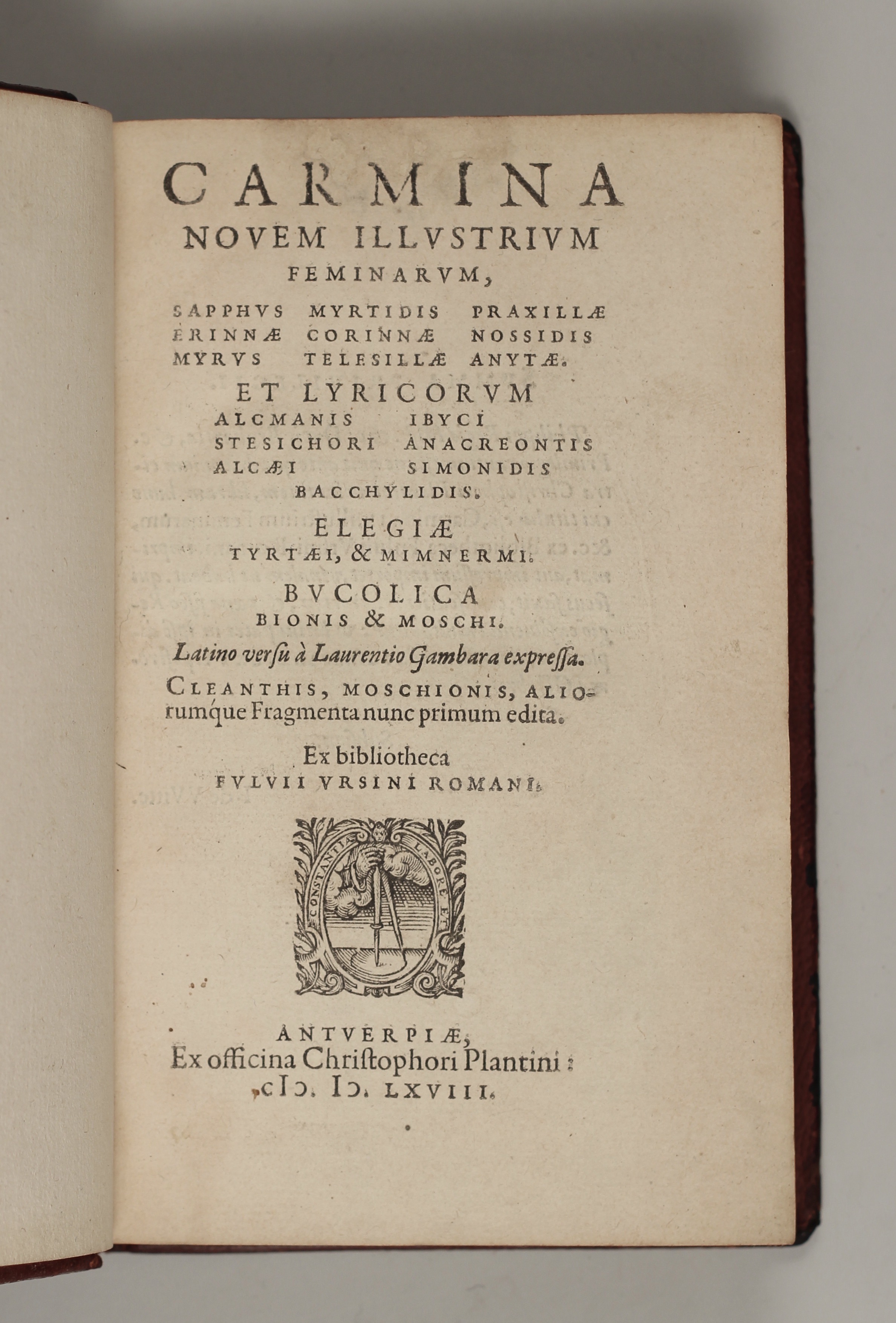Sappho, Myrtis e. a. / Σαπφώ, Μυρτὶς καὶ ἑπτὰ ἄλλαι
Carmina novem illustrium feminarum … — Antwerp 1568
4.000 €Carmina novem illustrium feminarum, Sapphus, Myrtidis, Praxillae, Erinnae, Corinnae, Nossidis, Myro, Telesillae, Anytae.
Et lyricorum Alcmanis, Ibyci, Stesichori, Anacreontis, Alcaei, Simonides, Bacchylidis.
Elegiae Tyrtaei, & Mimnermi.
Bucolica Bionis & Moschi. Latino versu a Laurentio Gambara expressa.
Cleanthis, Moschionis, aliorumque fragmenta nunc primum edita.
Ex bibliotheca Fulvii Ursini Romani. — Antverpiae, Ex officina Christophori Plantini, M CIↃ. IƆ. LXVIII. [Antwerpen, Plantin, 1568].
Editio princeps
8vo (167 x 104 mm). *6 A-Y8 Z2 a,b8: (6) ff., 387 pp. 18th century red morocco, spine gilt; a few skilfull restaurations to the binding. Paper restoration to the upper margin of the title-page and to the blank margin of the second leaf (Orsini’s dedication to Allessandro Farnese). Apart from that a nice and fresh copy. Printed in Greek & Latin. – Hoffmann III 234; Adams P 1802 (Poetae).
See Anne Debrosse, Èditer et publier des poétesses grecques à la renaissance. Les choix éditoriaux de Fulvio Orsini et Christope Plantin (1568), in: Cuny, Diane (Ed.), Les femmes illustres de l’Antiquité grecque au miroir des modernes (XIVe-XVIe siècle) ; avec un hommage à Christophe Plantin. Paris 2020, pp. 55-72.
The Plantin Press Online cp011693:
Fulvius Ursinus was a protégé of Cardinal Granvelle and as much to oblige the powerful prelate as for the cultural importance of Ursinus’s publications, Plantin printed a number of works by the Roman scholar. In October 1567, in a letter written in Italian to Ursinus, Plantin said he was waiting for the ‚fragmenti delli nove lirici et le nove poetesse con li due poete bucolici et li due elegi‘, and would immediately print them in 16mo (Corr., I, no. 90) (cf. letter of Plantin to S. Winandus Pighius, 4 November 1567 [L. Voet, ‚Plantin en de kring van Granvelle‘ in De Gulden Passer, 37, 1959, page 166]: ‚Accepi his diebus a D. Malpas [attendant of Granvelle at Rome] litteras a D. Fulvio Ursino, qui scribit se dedisse exemplar Poeticarum Lyricarum R. et illustration Dn. Cardinali ad me mittendum‘). That same month, on 25 October 1567, Granvelle wrote to Plantin that he had shipped the manuscript (‚Ces deux motz seront seullement pour encheminer la copie que vous envoye le Seigneur Fulvio Ursino avec ses lectres des fragmentz des poetes et preteresses lyriques, que vous avez desiré‘: Suppl. Corr., no. 42). The copy was sent by Granvelle to his attendant in the Netherlands, Maximilian Morillon, with the order to forward it to Plantin (letter of Granvelle, 22 November 1567: Suppl. Corr., no. 44). From then on ‚les poetes et preteresses‘ figure frequently in the correspondence between Granvelle and Plantin, mostly demands formulated by the prelate to speed up the printing and explications by Plantin why there have been delays (letter to Granvelle, end of December 1567 or beginning of January 1568: Corr., I, no. 99; of Granvelle, 2 January 1568: Suppl. Corr., no. 48; of Granvelle, 29 January 1568: Ibidem, no. 49). On 23 January 1568 Plantin, in a letter to Ursinus himself, gives some interesting information (Corr., I, no. 101): he has received some weeks ago the manuscript by way of Cardinal Granvelle and will commission immediately the cutting of ‚l’effigie de Sappho‘ to illustrate the work; when finished the printer will mail a bound copy to Cardinal Farnese as aked for by Ursinus; he thanks the scholar for having ordered a Latin translation of the fragments of Moschus and Bio (to judge from the context a favour Plantin himself had asked for) by Lorenzo Gambara; he explains that this translation will follow the Greek texts so as to be separated from them, but that it will be announced in the title-page (as has been done). Some weeks later, on 21 February 1568, Plantin let it be known to Ursinus that he started printing the text according to the included ‚monstre‘ (= in fact quire A), and hoped to have finished the publication within some three weeks; when Ursinus didn’t already had mailed the dedicatory by now, the printing would be achieved before it reached Antwerp (Corr., I, no. 109). A week later, on 28 February 1568, Plantin sent Granvelle the first two sheets (quires A and B), explaining also that he hopes to have finished the printing within three weeks and expressing the wish to receive the dedicatory before that term as to be able to achieve the publication without interruption (Ibidem, no. 110). The dedicatory had not yet reached Antwerp on 8 March 1568 when Plantin mailed three other quires to Ursinus (Ibidem, no. 113). The printer didn’t mention the dedicatory when announcing on 26 March 1568 to Granvelle the mailing of quires G – H – I, affirming that the printing would be completed before Easter (Corr., III, no. 355). The dedicatory, however, did not have arrived yet: it was only on 10 April 1568 that Granvelle stated the mailing to Plantin of the foreword and of the translation of Gambara (Suppl. Corr., no. 57). On 2 May Plantin wrote back that he would have finished within 8 days with everything he had as yet received of the ‚fragments poetiques‘ (Ibidem, no. 61; cf. the answer of Granvelle, letter of 24 May 1568: Ibidem, no. 66). In later letters between Plantin and Granvelle mention is made of the mailing of some copies to the Cardinal: letter of Granvelle, 30 September 1568 (Suppl. Corr., no. 75); of Granvelle, 19 November 1568 (Ibidem, no. 78); to Granvelle, 10 December 1568 (Corr., II, no. 159); to Granvelle, 31 December 1568 (Ibidem, no. 163); of Granvelle, 15 January 1569 (Suppl. Corr., no. 80); of Granvelle, 17 March 1569 (Ibid., no. 84).









